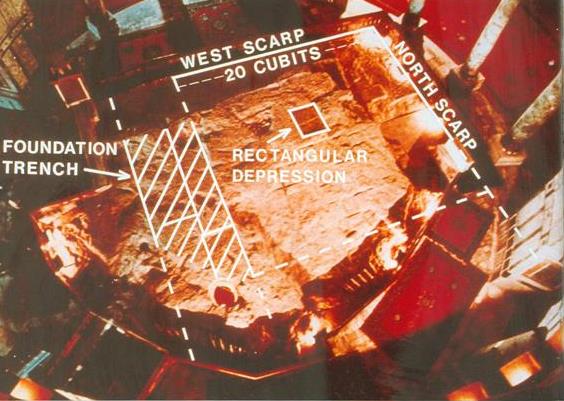View of the Rock showing the location of the Holy of Holies. On the left is the foundation trench for the southern wall of the Holy of Holies. The western scarp measures 20 cubits, as did each side of the Holy of Holies. The northern scarp had originally been cut to fit these measurements. The partition between the Holy of Holies (Dvir) is indicated by a broken line.
Two distinctive depressions are visible, almost side by side in the northern part of the rock. The southernmost of these (on left in the photograph) is an apparently artificially cut trapezoid indentation with two ledges spreading out toward the west. In the deepest point, no rock is visible, only small stones and mortar. It has been suggested that this place may be of special importance as the planting place for a tree for Ashera. However, as this place is located at the very center of the Dome of the Rock, it may have played a role as the central pivot from which the plan of the Dome of the Rock was set out on the ground for its construction.
Just to the north of this is a rectangular depression, the sides of which have an estimated height of 0.5 to 6 inches (1 to 15 cm). The identification of this depression proved to be the most moving part of the entire research. Although we had not gone looking for a sensational find, but had simply homed in from the exterior walls of the Temple Mount on the interior of the Temple itself, the location of this feature pointed to its identification as the former resting-place of the Ark of the Covenant. According to this plan, it falls exactly in the center of the Holy of Holies. The dimensions of this level basin agree with those of the Ark of the Covenant which were 1.5 cubits (2 ft. 7 in. x 4 ft. 4 in. or 79 cm x 131 cm), with the longitudinal axis coinciding with that of the Temple. It appears therefore that during the First Temple period a special place was prepared for the Ark by cutting this flat basin in the rock. It is clear that without such a flat area the Ark would have wobbled about in an undignified manner, which would not conceivably have been allowed.
Apart from the depressions mentioned above, many cuts were made in the Rock during the period of Crusader domination of the Temple Mount when the Christians built a church called Templum Domini over the Rock. The cuts visible on the eastern slope of the Rock are the result of a Crusader practice of raising money by selling pieces of the rock for their weight in gold.
Leen and Kathleen Ritmeyer. From Sinai to Jerusalem- The Wanderings of the Holy Ark. Carta, Jerusalem, 2000. p.70.
